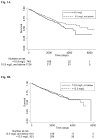Associations between alpha-tocopherol, beta-carotene, and retinol and prostate cancer survival
- PMID: 19383902
- PMCID: PMC2787239
- DOI: 10.1158/0008-5472.CAN-08-4640
Associations between alpha-tocopherol, beta-carotene, and retinol and prostate cancer survival
Abstract
Previous studies suggest that carotenoids and tocopherols (vitamin E compounds) may be inversely associated with prostate cancer risk, yet little is known about how they affect prostate cancer progression and survival. We investigated whether serum alpha-tocopherol, beta-carotene, and retinol concentrations, or the alpha-tocopherol and beta-carotene trial supplementation, affected survival of men diagnosed with prostate cancer during the alpha-Tocopherol, beta-Carotene Cancer Prevention Study, a randomized, double-blind, placebo-controlled primary prevention trial testing the effects of beta-carotene and alpha-tocopherol supplements on cancer incidence in adult male smokers in southwestern Finland (n = 29,133). Prostate cancer survival was examined using the Kaplan-Meier method with deaths from other causes treated as censoring, and using Cox proportional hazards regression models with hazard ratios (HR) and 95% confidence intervals (CI) adjusted for family history of prostate cancer, age at randomization, benign prostatic hyperplasia, age and stage at diagnosis, height, body mass index, and serum cholesterol. As of April 2005, 1,891 men were diagnosed with prostate cancer and 395 died of their disease. Higher serum alpha-tocopherol at baseline was associated with improved prostate cancer survival (HR, 0.67; 95% CI, 0.45-1.00), especially among cases who had received the alpha-tocopherol intervention of the trial and who were in the highest quintile of alpha-tocopherol at baseline (HR, 0.51; 95% CI, 0.20-0.90) or at the 3-year follow-up measurement (HR, 0.26; 95% CI, 0.09-0.71). Serum beta-carotene, serum retinol, and supplemental beta-carotene had no apparent effects on survival. These findings suggest that higher alpha-tocopherol (and not beta-carotene or retinol) status increases overall prostate cancer survival. Further investigations, possibly including randomized studies, are needed to confirm this observation.
Figures

Similar articles
-
Dietary and serum alpha-tocopherol, beta-carotene and retinol, and risk for colorectal cancer in male smokers.Eur J Clin Nutr. 2002 Jul;56(7):615-21. doi: 10.1038/sj.ejcn.1601366. Eur J Clin Nutr. 2002. PMID: 12080400 Clinical Trial.
-
The association between lung and prostate cancer risk, and serum micronutrients: results and lessons learned from beta-carotene and retinol efficacy trial.Cancer Epidemiol Biomarkers Prev. 2003 Jun;12(6):518-26. Cancer Epidemiol Biomarkers Prev. 2003. PMID: 12814997 Clinical Trial.
-
Serum retinol and risk of prostate cancer.Am J Epidemiol. 2011 Apr 1;173(7):813-21. doi: 10.1093/aje/kwq429. Epub 2011 Mar 9. Am J Epidemiol. 2011. PMID: 21389041 Free PMC article. Clinical Trial.
-
Serum Retinol and Risk of Overall and Site-Specific Cancer in the ATBC Study.Am J Epidemiol. 2020 Jun 1;189(6):532-542. doi: 10.1093/aje/kwz226. Am J Epidemiol. 2020. PMID: 31612201 Free PMC article. Clinical Trial.
-
Factors influencing blood concentration of retinol, alpha-tocopherol, vitamin C, and beta-carotene in the French participants of the SU.VI.MAX trial.Eur J Clin Nutr. 2006 Jun;60(6):706-17. doi: 10.1038/sj.ejcn.1602372. Epub 2006 Jan 4. Eur J Clin Nutr. 2006. PMID: 16391586
Cited by
-
Recent Progress in Discovering the Role of Carotenoids and Metabolites in Prostatic Physiology and Pathology-A Review-Part II: Carotenoids in the Human Studies.Antioxidants (Basel). 2021 Feb 20;10(2):319. doi: 10.3390/antiox10020319. Antioxidants (Basel). 2021. PMID: 33672578 Free PMC article. Review.
-
Role of vitamin and mineral supplementation and aspirin use in cancer survivors.J Clin Oncol. 2010 Sep 10;28(26):4081-5. doi: 10.1200/JCO.2009.27.3219. Epub 2010 Aug 9. J Clin Oncol. 2010. PMID: 20697066 Free PMC article. Review.
-
Chemoprevention of prostate cancer with nutrients and supplements.Cancer Manag Res. 2011;3:91-100. doi: 10.2147/CMR.S18503. Epub 2011 Apr 6. Cancer Manag Res. 2011. PMID: 21629831 Free PMC article.
-
Tocopherols in cancer: An update.Mol Nutr Food Res. 2016 Jun;60(6):1354-63. doi: 10.1002/mnfr.201500847. Epub 2016 Feb 2. Mol Nutr Food Res. 2016. PMID: 26751721 Free PMC article. Review.
-
Vitamins and prostate cancer risk.Molecules. 2010 Mar 12;15(3):1762-83. doi: 10.3390/molecules15031762. Molecules. 2010. PMID: 20336012 Free PMC article. Review.
References
-
- Jemal A, Siegel R, Ward E, et al. Cancer Statistics. CA Cancer J Clin. 2008;58:71–96. - PubMed
-
- Signorello LB, Adami H-O. Prostate Cancer. In: Adami H-O, Hunter D, Trichopoulos D, editors. Textbook of Cancer Epidemiology. Oxford: Oxford University Press; 2002.
-
- Sequoia JSP, Wright ME, McCarron P, et al. A Prospective Investigation of Height and Prostate Cancer Risk. Cancer Epidemiol Biomarkers Prev. 2006;15:2174–2178. - PubMed
-
- Montgomery RB, Goldman B, Tangen CM, et al. Association of Body Mass Index With Response and Survival in Men With Metastatic Prostate Cancer: Southwest Oncology Group Trials 8894 and 9916. J Urol. 2007;178:1946–1951. - PubMed
Publication types
MeSH terms
Substances
Grants and funding
LinkOut - more resources
Full Text Sources
Medical
Research Materials
Miscellaneous

